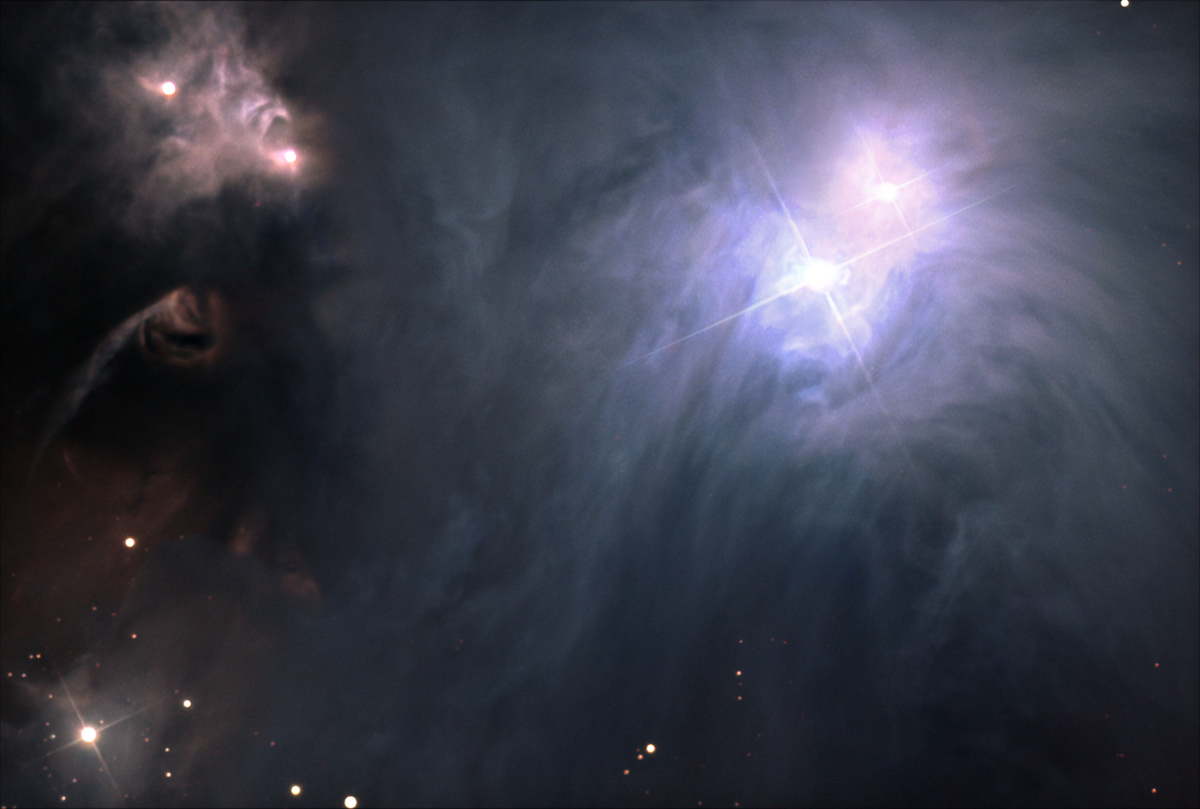
[back] NGC 6726/27/29 in Corona Australis [NED]

|
(c) 2004 All astro photo images are copyrighted. They may not be used or reproduced without explicit written permission from the authors. |
|
60" |
|
About this Image / Über dieses Bild
| CCD: | ST10 XME |
| Image Type, Orientation: | LRGB Composite, North is at 2:00h |
| Exposure time: | L: 8x300 sec. 1x1 bin, R,G,B: 4x300 sec. 2x2 bin |
| Exposure date: | June 17th, 2004 |
| Location: | Capella Observatory at Amani Lodge, Kupferberg near Windhoek, Namibia |
| Filter: | FR03 + Astronomik Typ II H-Alpha,RGB filters |
| Instrument: | Ganymed 60cm-Hypergraph in secondary focus, f=4800 mm |
| Image seeing (FWHM): | 2.7" |
| Photographer: | Josef Pöpsel, Beate Behle |
| Remarks: |
This image shows NGC 6726 (lower part of the bright nebula on the right side), NGC 6727 (upper part) and NGC 6729 (upper left corner). In addition you can see the Herbig-Haro-Object HH100 (the "hook", see also HH46-47). An image of the same area, which was photographed in the primary focus of Ganymed at f=1800mm can be found here. A wide field image of this region can be found here. NGC 6729 is a so called variable nebula. Its appearance changes rapidly (during some years). It is believed, that parts of the nebula near the two illuminating stars cast shadow onto those parts of itself, which are more far away. During our exposure the simmilarity of the nebula to "The Flounder" of Günter Grass was amazing (see left). Image processed with CCD-Sharp and digital development (DDP). |
|
|
|
| Bemerkungen:
|
Im Bild sind NGC 6726 (der untere Teil des hellen Nebels rechts im Bild), NGC 6727 (der obere Teil) und NGC 6729 (linke obere Ecke) zu sehen. Außerdem befindet sich unter NGC 6729 das Herbig-Haro-Objekt HH100 (der "Haken", siehe hierzu auch HH46-47). Eine Aufnahme desselben Gebiets, die im Primärfokus von Ganymed bei f=1800mm gemacht wurde, ist hier zu finden. Eine Aufnahme, die ein weiteres Feld dieser Himmelsregion zeigt, befindet sich hier. Bei NGC 6729 handelt es sich um einen variablen Nebel, der innerhalb recht kurzer Zeit (einiger Jahre) sein Aussehen verändern kann. Man nimmt an, dass dies durch Schatten des Nebels, der nahe an den beiden beleuchtenden Sternen liegt, auf weiter entferne Teile von sich selbst hervorgerufen wird. Zum Zeitpunkt der Aufnahme hatte der Nebel erstaunliche Ähnlichkeit mit dem "Butt" von Günter Grass (siehe links). Das Bild wurde mit Hilfe von CCD-Sharp und "digital development" (DDP) bearbeitet. |
Back to the Diffuse Nebulae Overview / Zurück zur Diffuse-Nebel-Übersichtsseite